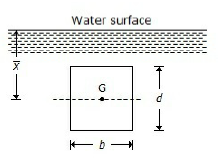A vertically immersed surface is shown in the below figure. The distance of its centre of pressure from the water surface is 
(bd²/12) + x
(d²/12 x) + x
b²/12 + x
d²/12 + x
Correct Answer :
B. (d²/12 x) + x
Related Questions
Barometer is used to measure
Pressure in pipes, channels etc.
Atmospheric pressure
Very low pressure
Difference of pressure between two points
If w is the specific weight of liquid and k the depth of any point from the surface, then pressure intensity at that point will be
h
wh
w/h
h/w
A square surface 3 m × 3 m lies in a vertical line in water pipe its upper edge at water surface. The hydrostatic force on square surface is
9,000 kg
13,500 kg
18,000 kg
27,000 kg
Bernoulli equation deals with the law of conservation of
Mass
Momentum
Energy
Work
Alcohol is used in manometers because
It has low vapour pressure
It is clearly visible
It has low surface tension
It can provide longer column due to low density
An opening in the side of a tank or vessel such that the liquid surface with the tank is below the top edge of the opening, is called
Weir
Notch
Orifice
None of these
The rise or depression of liquid in a tube due to surface tension will increase in size of tube will
Increase
Remain unaffected
May increase or decrease depending on the characteristics of liquid
Decrease
In a depressed nappe
The pressure below the nappe is atmospheric
The pressure below the nappe is negative
The pressure above the nappe is atmospheric
The pressure above the nappe is negative
The centre of pressure acts __________ the centre of gravity of immersed surface.
At
Above
Below
None of these
The absolute pressure is equal to
Gauge pressure + atmospheric pressure
Gauge pressure - atmospheric pressure
Atmospheric pressure - gauge pressure
Gauge pressure - vacuum pressure
When a cylindrical vessel, containing some liquid, is rotated about its vertical axis, the liquid surface is depressed down at the axis of its rotation and rises up near the walls of the vessel on all sides. This type of flow is known as
Steady flow
Turbulent flow
Vortex flow
Uniform flow
The liquid used in manometers should have
Low density
High density
Low surface tension
High surface tension
A moving fluid mass may be brought to a static equilibrium position, by applying an imaginary inertia force of the same magnitude as that of the accelerating force but in the opposite direction. This statement is called
Pascal's law
Archimedess principle
D-Alembert's principle
None of these
When the flow parameters at any given instant remain same at every point, then flow is said to be
Quasi-static
Steady state
Laminar
Uniform
When a body floating in a liquid, is displaced slightly, it oscillates about
C.G. of body
Center of pressure
Center of buoyancy
Metacentre
Rotameter is a device used to measure
Absolute pressure
Velocity of fluid
Flow
Rotation
The pressure less than atmospheric pressure is known as
Suction pressure
Vacuum pressure
Negative gauge pressure
All of these
The increase in pressure at the outer edge of a drum of radius (r) completely filled up with liquid of density (ρ) and rotating at (ω) rad/s is
ρ ω2 r2
2ρ ω2 r2
ρ ω2 r2/2
ρ ω2 r2/4
When a body is immersed wholly or partially in a liquid, it is lifted up by a force equal to the weight of liquid displaced by the body. This statement is called
Pascal's law
Archimedess principle
Principle of floatation
Bernoulli's theorem
The shear stress between the two liquid layers is __________ proportional to the distance between two layers.
Directly
Inversely
Both A and B
None of these
According to Bernoulli's equation for steady ideal fluid flow
Principle of conservation of mass holds
Velocity and pressure are inversely proportional
Total energy is constant throughout
The energy is constant along a streamline but may vary across streamlines
Which of the following instrument can be used for measuring speed of an aeroplane?
Venturimeter
Orifice plate
Pitot tube
Rotameter
A flow whose streamline is represented by a curve, is called
One-dimensional flow
Two-dimensional flow
Three-dimensional flow
Four-dimensional flow
The depth of the centre of pressure on a vertical rectangular gate 8 m wide and 6 m high, when the water surface coincides with the top of the gate, is
2.4 m
3.0 m
4.0 m
5.0 m
With an increase in size of tube, the rise or depression of liquid in the tube due to surface tension will
Decrease
Increase
Remain unchanged
Depend upon the characteristics of liquid
The siphon will work satisfactorily, if the minimum pressure in the pipe is __________ vapour pressure of liquid.
Equal to
Less than
More than
None of these
The discharge through a wholly drowned orifice is given by (where H1 = Height of water (on the upstream side) above the top of the orifice, H2 = Height of water (on the downstream side) above the bottom of the orifice, and H = Difference between two water levels on either side of the orifice)
Q = Cd × bH₁ × √(2gh)
Q = Cd × bH2 × √(2gh)
Q = Cd × b (H2 - H1) × √(2gh)
Q = Cd × bH × √(2gh)
A notch is used to measure __________ of liquids.
Pressure
Discharge
Velocity
Volume
For very great pressures, viscosity of moss gases and liquids
Remain same
Increases
Decreases
Shows erratic behaviour
The pressure measured with the help of a pressure gauge is called
Atmospheric pressure
Gauge pressure
Absolute pressure
Mean pressure
